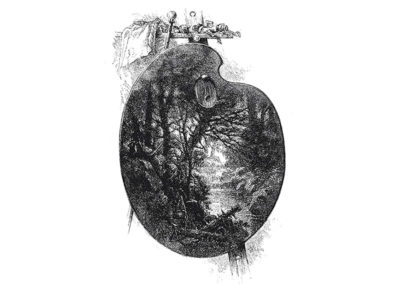Mark Twain’s first article for Harper’s Magazine was misattributed to Mark Swain. The article, “Forty-three Days in an Open Boat” (December 1866), is an account of the Hornet, a clipper ship that caught fire in the open ocean, leaving its crew adrift for forty-three days. Twain referred to it as the “first magazine article I ever published,” though he had published numerous other pieces under such names as Thomas Jefferson Snodgrass; W. Epaminondas Adrastus Blab; Rambler; Grumbler; and Peter Pencilcase’s Son, John Snooks; and had already received some renown for his short story “The Celebrated Jumping Frog of Calaveras County.”
Twain had been born thirty-one years earlier, and two months premature, as Samuel Langhorne Clemens, in Florida, Missouri. “When I first saw him I could see no promise in him,” his mother said. The Clemenses moved several miles upstate, to the Mississippi River–side Hannibal, when he was four; the town would later inspire the fictional St. Petersburg of his two most famous works, The Adventures of Tom Sawyer (1876) and The Adventures of Huckleberry Finn (1885).
Twain frequently claimed his favorite of his own books was Personal Recollections of Joan of Arc (1896), which was first serialized in Harper’s between April 1895 and April 1896. His interest in Joan of Arc had been sparked as a child in Hannibal when a loose page from a book chronicling her imprisonment whisked into his path. “This is to be a serious book,” Twain said of Personal Recollections to his wife, Olivia, and his daughter Susy, on whom he partly modeled his Joan. “It means more to me than anything I have ever undertaken.” But out of concern that the book would “never be accepted seriously under [his] own signature,” his name was not included on the title page, which read, in full: “Personal Recollections of Joan of Arc, by the Sieur Louis de Conte (Her Page and Secretary), Freely Translated Out of the Ancient French into Modern English from the Original Unpublished Manuscript in the National Archives of France, by Jean François Alden.” (The ostensible translator’s name may have derived, perhaps sarcastically, from that of Harper’s editor Henry M. Alden.) It was also his longest novel.
In August and September of that same year, Harper’s serialized Tom Sawyer, Detective, which Twain only wrote for the money. “You might, if you only read Tom Sawyer, Detective, think that Mark Twain was an unrepentant and callous racist,” Walter Mosley wrote a century later, when it was published with several of Twain’s other detective stories. “I wouldn't suggest these stories to a hardcore mystery reader,” Mosley added. “But I would suggest them to anyone who wants a view of the mind and flaws of a bygone people — a people whose imperfections we can still see in our daily lives.” Twain also wrote the Harper’s Editor’s Drawer column and the magazine published many of his most revered stories and articles, among them “Mental Telegraphy,” “A Majestic Literary Fossil,” “A Petition to the Queen of England,” “Was it Heaven? Or Hell?,” and several posthumous additions to his “Unpublished Chapters from the Autobiography of Mark Twain.”
Twain was a Freemason, a member of the Society for Psychical Research, and an honorary member of Yale University’s secret society Scroll and Key. He received an honorary degree from Oxford University and, according to the New York Times, was “Suggested for the Honor” of the 1907 Nobel Prize in Literature. Public schools, a former U.S. Army installation in Germany, a bridge, an asteroid, and at least three awards are named after him.









































































































